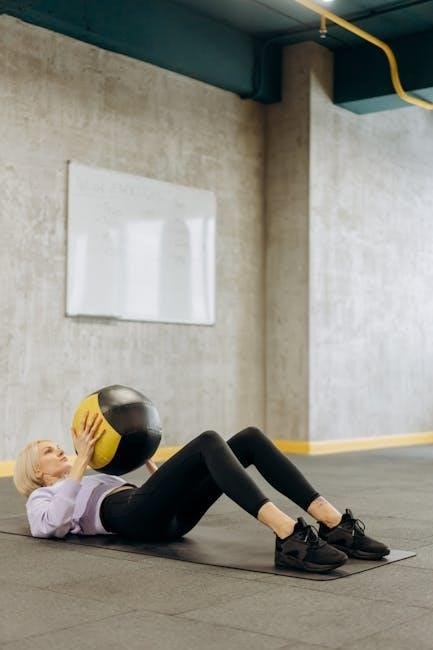Core stabilization exercises are essential for improving posture, balance, and overall physical performance. They target deep abdominal muscles to enhance stability and reduce injury risk. These exercises promote better movement patterns and are vital for athletes and individuals seeking enhanced physical efficiency. Incorporating them into a workout routine can lead to improved endurance and stronger core engagement.
- Enhances posture and reduces back pain.
- Improves balance and stability.
- Prevents injuries and supports athletic performance.
1.1 What Are Core Stabilization Exercises?
Core stabilization exercises are movements designed to strengthen the muscles that support the spine and pelvis, enhancing overall stability and control. These exercises focus on engaging the deep abdominal muscles, such as the transverse abdominis, to improve posture, balance, and movement efficiency. They often involve maintaining neutral spine alignment during static or dynamic movements, like planks or bird dogs, to promote proper muscle activation and prevent excessive motion that could lead to injury. Proper form and controlled movements are key to their effectiveness.
1.2 Benefits of Core Stabilization for Posture and Performance
Core stabilization enhances posture by strengthening the muscles that support the spine, reducing slouching and improving alignment. It boosts athletic performance by providing a stable base for movements, enhancing power and efficiency. Better balance and reduced injury risk are also significant benefits, as a strong core helps maintain control during dynamic activities. These exercises are versatile, benefiting both everyday activities and high-level sports, making them a fundamental component of any fitness regimen.

Understanding the Core Anatomy
The core comprises abdominal muscles, obliques, and the transverse abdominis, which work together to stabilize the body and support movements. Understanding their functions aids in effective core training.
2;1 Major Muscle Groups Involved in Core Stabilization
The core’s major muscle groups include the rectus abdominis, external obliques, internal obliques, and transverse abdominis. These muscles work collectively to provide stability and support for the spine and pelvis. The rectus abdominis, often visible as a six-pack, facilitates flexion, while the obliques assist in rotation and lateral flexion. The transverse abdominis acts as the body’s natural corset, wrapping around the spine to offer deep stabilization. Together, these muscles ensure efficient movement and proper posture.
2.2 The Role of the Transverse Abdominis Muscle
The transverse abdominis muscle is the deepest abdominal muscle, playing a crucial role in core stabilization. It wraps around the spine and pelvis, acting as a natural corset to provide compression and stability. By engaging the transverse abdominis, individuals can enhance spinal alignment, reduce lower back strain, and improve movement efficiency. This muscle is essential for generating intra-abdominal pressure, which supports the body during lifting, twisting, and other dynamic movements. Proper activation of this muscle is vital for optimal core function and stability.

Importance of Core Stabilization
Core stabilization is crucial for maintaining proper posture, enhancing balance, and improving physical performance. It reduces injury risks by strengthening the muscles that support the spine and pelvis.
3.1 Enhancing Balance and Stability
Core stabilization exercises significantly improve balance and stability by strengthening the muscles that support the spine and pelvis. A strong core acts as a foundation, enabling better control during movements. This stability enhances proprioception, reducing the risk of injuries and falls. For athletes, improved balance translates to better performance in sports requiring precision and agility. Incorporating these exercises into a routine promotes overall physical efficiency and confidence in daily activities and athletic endeavors.
- Reduces risk of falls and injuries.
- Enhances athletic performance.
- Improves posture and movement control.
3.2 Improving Athletic Performance
Core stabilization exercises are crucial for improving athletic performance by enhancing power, endurance, and overall efficiency. A strong core enables better energy transfer between upper and lower body movements, optimizing sports-specific actions like throwing, swinging, or kicking. It also improves posture, reducing energy waste during activities. For athletes, this translates to faster recovery, better endurance, and reduced injury risk. Strengthening the core muscles is essential for peak performance in any sport requiring strength, speed, and precision.
- Enhances power and energy transfer.
- Reduces injury risk and improves recovery.
- Optimizes sports-specific movements.
3.3 Preventing Injuries Through Core Strength
Core stabilization exercises play a vital role in injury prevention by strengthening the muscles that support the spine and pelvis. A strong core provides stability, reducing the risk of strains and poor movement patterns. It acts as a protective mechanism during dynamic activities, minimizing stress on joints. Strengthening the transverse abdominis and obliques helps maintain proper posture and alignment, reducing the likelihood of overuse injuries. A stable core is essential for absorbing and transferring forces efficiently, ensuring safer and more effective movements.
- Reduces risk of muscle strains and poor form.
- Protects joints from excessive stress.
- Enhances overall movement resilience.
- Strengthen deep abdominal muscles.
- Enhance spinal stability and control.
- Support functional movement patterns.
- Forearm plank strengthens the transverse abdominis.
- Side planks target the obliques for better rotational stability.
- Incline planks challenge the core on an unstable surface.
- Plank jacks add a dynamic element for functional fitness.
- Targets transverse abdominis and obliques.
- Improves posture and reduces lower back strain.
- Enhances balance and coordination.
- Targets transverse abdominis and pelvic floor muscles.
- Improves posture and reduces lower back strain.
- Enhances core stability and activation.
- Enhance functional strength.
- Improve stability during movement.
- Boost athletic performance.
- Targets oblique muscles for rotational strength.
- Enhances core endurance and stability.
- Improves movement patterns and reduces injury risk;
- Strengthens obliques for anti-rotation stability.
- Enhances rotational strength and control.
- Improves core function and reduces injury risk.
- Improves functional strength and stability.
- Mimics real-life movements for practical benefits.
- Enhances posture and reduces injury risk.
- Essential for improving athletic performance.
- Reduces injury risks in sports.
- Enhances stability and control during movements.
- Bird dog exercise improves balance and stability.
- Pelvic tilts strengthen core and pelvic muscles.
- Enhances running efficiency and reduces injury risks.
- Targets obliques and transverse abdominis muscles.
- Enhances rotational strength and stability.
- Improves posture and functional movement patterns.
- Start with 10-15 minute core sessions.
- Focus on dynamic and static exercises.
- Combine with strength training for optimal results.
- Plank: 30-60 seconds, targets core stability and endurance.
- Bird Dog: 10-15 reps per side, enhances balance and control.
- Pelvic Clock: 5-8 minutes, activates deep core muscles.
- Progress: Add weight, reps, or complexity.
- Regress: Simplify movements or reduce intensity.
- Keep shoulders relaxed and down.
- Maintain a neutral spine position.
- Breathe naturally without holding breath.
- Engage the transverse abdominis muscle.
- Avoid using momentum or secondary muscles.
- Focus on controlled, precise movements;
Essential Core Stabilization Exercises
Core stabilization exercises are foundational for building strength and stability. They focus on engaging key muscles to improve posture, balance, and overall physical performance effectively and safely.
4.1 Plank Variations for Core Engagement
Plank variations are highly effective for core engagement, targeting the abdominals, obliques, and lower back muscles. They improve posture, stability, and overall core strength when performed correctly.
Regular plank practice enhances muscle endurance and reduces injury risk, making it a cornerstone of core stabilization routines.
4.2 Bird Dog Exercise for Stability and Control
The Bird Dog exercise is a dynamic movement that enhances core stability and control by engaging the abdominals and lower back muscles. It involves kneeling on all fours, extending one arm and the opposite leg while maintaining a neutral spine. This exercise improves balance, posture, and coordination, making it ideal for athletes and individuals seeking enhanced core stability. Regular practice strengthens the deep stabilizers, reducing the risk of injury and improving overall physical performance.
4.3 Pelvic Clock Exercise for Core Activation
The Pelvic Clock Exercise is a simple yet effective core activation technique that targets the deep stabilizers of the pelvis and lower back. Performed by lying on your back with knees bent, it involves tilting the pelvis in a “clock-like” motion, engaging the transverse abdominis muscle. This exercise improves posture, reduces lower back pain, and enhances core stability by strengthening the pelvic floor and abdominal muscles; Regular practice promotes better movement patterns and overall core engagement.

Dynamic Core Stabilization Exercises
Dynamic core stabilization exercises enhance functional strength and athletic performance by incorporating movement. They improve stability during dynamic activities, reducing injury risk and boosting overall core resilience.
5.1 Cable Rotations for Oblique Strength
Cable rotations target the oblique muscles, enhancing rotational strength and stability. This exercise improves core endurance while promoting proper movement patterns. By focusing on controlled rotations, it strengthens the muscles around the torso, enhancing overall athletic performance and reducing injury risk.
5.2 Pallof Press for Anti-Rotation Stability
The Pallof Press is a dynamic exercise that strengthens anti-rotation stability by engaging the obliques and core muscles. It involves pressing a cable or resistance band away from the body while maintaining a neutral spine. This exercise enhances rotational strength and stability, improving overall core function and reducing injury risk during movements requiring rotational force.
5.3 Dynamic Plank Variations for Functional Movement
Dynamic plank variations are advanced exercises that challenge the core by incorporating movement while maintaining stability. They enhance functional strength and improve muscle engagement, mimicking real-life movements. These exercises are ideal for improving posture, balance, and overall core stability. Variations include shoulder taps, knee drives, and lateral shifts, making them versatile for different fitness levels. Incorporating dynamic planks into a routine can boost core endurance and reduce injury risk during physical activities. They are highly effective for strengthening the entire core musculature.
Core Stabilization Exercises for Athletes
Core stabilization exercises are crucial for athletes to enhance performance and prevent injuries. They improve pelvis stability, essential for runners, and overall athletic efficiency. These exercises strengthen the core muscles, providing better balance and control during dynamic movements. Incorporating core sliders and other multi-planar exercises helps athletes maintain optimal form and endurance. Strong core stabilization is key to achieving peak performance and reducing injury risks in sports.
6.1 Exercises for Runners to Stabilize the Pelvis
For runners, stabilizing the pelvis is crucial to maintain proper form and reduce injury risk. Exercises like bird dog and pelvic tilts strengthen the muscles around the pelvis, improving balance and posture. These movements enhance core engagement, ensuring efficient energy transfer during runs. Consistent practice of these exercises can lead to better running mechanics and overall performance. Strengthening the pelvis also reduces the strain on lower back muscles, promoting long-term durability for athletes.
6.2 Core Sliders Workout for Multi-Planar Movement
Core sliders are an excellent tool for engaging the core in multi-planar movements, which mimic real-life and sports-specific actions. Exercises like lateral sliders and slider-assisted leg curls target the obliques and transverse abdominis, enhancing rotational strength and stability. These movements improve posture, reduce injury risk, and boost functional movement patterns. Incorporating sliders into a workout routine challenges the core in dynamic ways, preparing the body for complex physical demands and improving overall athletic performance. Regular practice strengthens the deep abdominal muscles, promoting better balance and coordination.

Incorporating Core Stabilization into Daily Workouts
Incorporating core stabilization exercises into daily workouts enhances overall fitness by improving balance, posture, and functional movement. Consistency is key for long-term benefits and injury prevention.
7;1 Sample Core Stabilization Exercise Routine
A well-rounded core stabilization routine includes planks, bird dogs, and pelvic clocks. Start with a 10-minute dynamic warm-up, then perform 3 sets of each exercise.
Finish with stretching to improve flexibility and recovery.
7.2 Progressing and Regressing Exercises Based on Fitness Level
Exercises can be modified to suit different fitness levels. Start with foundational movements and gradually increase intensity for advanced individuals. For beginners, simplify exercises by reducing range of motion or using support. Progress by adding dynamic variations or resistance. Always prioritize proper form to prevent injury and ensure effectiveness. Adjusting exercises based on fitness level ensures a safe and challenging workout for everyone;
Common Mistakes to Avoid in Core Stabilization Exercises
Avoid rounding shoulders, arching the back, or holding breath. Poor form can lead to injury and reduce exercise effectiveness. Maintain proper posture and engage core muscles correctly for optimal results and safety.
8.1 Maintaining Proper Form to Prevent Injury
Maintaining proper form is crucial in core stabilization exercises to prevent injury. Avoid rounding shoulders, arching the back, or holding breath, as these can strain muscles. Ensure neutral spine alignment and engage the core throughout movements. Poor form can lead to ineffective workouts and potential harm. Focus on controlled, slow movements and use appropriate breathing techniques to maximize safety and effectiveness. Proper form ensures target muscles are activated correctly, enhancing results while minimizing injury risk.
8.2 Avoiding Overreliance on Accessory Muscles
Overreliance on accessory muscles, such as the shoulders or hips, can undermine the effectiveness of core stabilization exercises. This often leads to poor form, muscle imbalances, and potential injuries. Focus on engaging the deep core muscles, like the transverse abdominis, to maintain proper stability. Avoid using momentum or secondary muscles to lift or move, as this can reduce the exercise’s benefits and increase injury risk. Prioritize controlled movements and mindful engagement of the target muscles for optimal results.
Core stabilization exercises are crucial for enhancing posture, balance, and performance. They strengthen deep abdominal muscles, reduce injury risk, and improve overall physical efficiency. Incorporate them into your routine for better stability and athletic performance.
9.1 Summary of the Importance of Core Stabilization
Core stabilization is vital for improving posture, balance, and overall physical performance. It strengthens deep abdominal muscles, enhances stability, and reduces injury risk. By engaging the core, individuals can achieve better movement patterns, supporting both athletic endeavors and daily activities. Strong core stabilization also promotes better endurance and efficiency in exercises, making it an essential component of any fitness routine. Its benefits extend to injury prevention and enhanced athletic performance, ensuring optimal physical function and longevity.
9.2 Encouragement to Implement Core Exercises into Training
Incorporating core stabilization exercises into your training regimen is a powerful way to enhance overall fitness and performance. By strengthening the core, you improve posture, balance, and reduce injury risks. These exercises are versatile and can be adapted to various fitness levels, making them accessible to everyone. Consistency is key, and even a few minutes daily can lead to significant improvements. Embrace core stabilization as a foundation for a stronger, more resilient body, and experience the benefits in both athletic and everyday activities.
